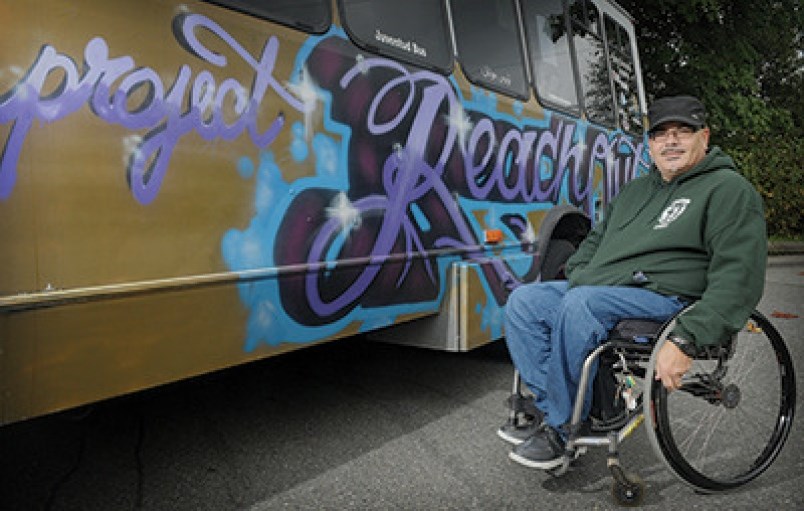When you work with vulnerable young people, the job does not always fit perfectly into an eight-hour day.
Samantha White, a youth engagement worker with Access Youth Outreach Services, said it is important that her phone stays on even after she has finished her shift.
“My kids know they can call me,” she told The Tri-City News, sitting at a table in the society’s offices at the Fernwood Lodge building on the Riverview Hospital lands. “They trust that they can get hold of me in the evenings.
“Anxiety, depression — situations don’t just end at 5 p.m.”
It is one of the things that has made Access — which celebrates its 25th birthday this year — so successful, according to Jerome Bouvier, the organization’s executive director. He said he strives to keep the service as open as possible to engage young people on their terms.
With a lot of youth-focused programs, “if you don’t check six out of the eight boxes, you don’t get in,” said Bouvier, who joined Access in 2004. “What we like to do is make it open.
“When you meet with a worker, they talk, they get a sense of if it fits for both and they get to work.”
When a young person is referred to the society, they are assessed and goals are put in place, Bouvier said. The youth engagement workers deal with between 15 and 17 clients at a time and approximately 50 to 60 take advantage of the services throughout the year.
“Some will go six months, some will go a year, some will go three months,” Bouvier said. “It all depends on the situation.”
One constant, however, is the need for services in the Tri-Cities.
While Bouvier currently has two youth engagement workers in the Access employ, he said he could easily keep a third person busy with the number of cases that get referred to his organization. More people are moving to the Tri-Cities, he said, and groups like Access need to keep up with demand.
“To do that, we have to have more money,” Bouvier said. “We just don’t have the ongoing funding dynamic.”
Youth engagement workers such as White interact with young people dealing with a range of issues. From mental health problems to substance abuse to anxiety and depression, she said, the open referrals mean that Access has to be flexible with how it approaches each case.
White facilitates a group of young people in the drama program but there are other activities, such as sports and yoga, that help participants become more comfortable with themselves and their surroundings, she said.
“One of the main goals is community inclusion,” White said. “The after-school theatre program is kind of a hot commodity right now but there are a lot of things. Yoga, summer walks, physical activity — it really depends on what the youth feel comfortable with.”
Access Youth Services started off in the early 1990s and was first known as the PoCoMo Teen Centre Society. Bouvier said in the early days, the volunteer-run group was trying to establish a drop-in centre for teens but experienced resistance from residents.
By the time he came aboard in 2004, the organization had changed its name to the PoCoMo Youth Services Society but programs were limited and they did not have a place for youth to congregate.
That’s when Bouvier launched the Reach Out bus.
The vehicle travels around the community to where young people congregate, giving them a place where they can feel safe to discuss their problems and be provided with information on issues like sex education and drugs.
“We have young people coming to us with a range of challenges,” Bouvier told The Tri-City News. “Maybe it is social anxiety — some are just trying to feel comfortable leaving the house — to even more core issues, transgender issues, identity issues, substance abuse issues.”
According to the organization’s 2016 Community Report, new trends and barriers among young people Access interacted with through the bus included an increase in the use of Xanax, fentanyl-laced drugs and homeless youth. Access is also seeing a rise in transgender youth reaching out for support — a positive development, said Bouvier, who noted that in the past many young people were reluctant to discuss their identity issues.”
Last year, Access staff on the bus interacted with 1,500 street-involved youth.
In a survey of 50 respondents outlined in Access’ 2016 Community Report, 57% said they had reduced their drug use after interacting with the Reach Out bus while 80% said they attended school more often and 65% said they feel safer in the community.
Access is also reaching out to youth through its social media platforms, which Bouvier said has allowed the organization to maintain constant contact with the kids it aims to help.
As busy as the service is, he added that the group is always ready to meet and work with young people in need.
“There is an opportunity for any young person to be involved, as long as they are working toward the goals they have set themselves,” he said. “If not, then it is a conversation around ‘Well, maybe you are not ready to do this.’
“We always have an open mind, though. Come back anytime and when you are ready to go, then we can rock on.”
BY THE NUMBERS
Referrals by City
• Coquitlam: 43%
• Port Coquitlam: 40%
• Port Moody: 9%
• Other: 8%
Referrals by Org.
• Government-funded agencies: 45%
• Community groups: 17%
• School District 43: 30%
• Other (self/family): 8%
Duration of Referrals
• One to three months: 38%
• Four to six months: 9%
• One to two years: 11%
• Ongoing: 42%
@gmckennaTC



